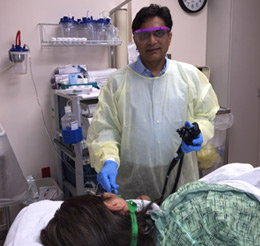
Upper endoscopy
enables the physician to look inside the
esophagus, stomach, and duodenum (first part
of the small intestine). The procedure might
be used to discover the reason for
swallowing difficulties, nausea, vomiting,
reflux, bleeding, indigestion, abdominal
pain, or chest pain. Upper endoscopy is also
called EGD, which stands for
esophagogastroduodenoscopy (eh-SAH-fuh-goh-GAS-troh-doo-AH-duh-NAH-skuh-pee).
It helps to examine the lining of these
organs, to biopsy and offer definitive
treatment. The scope also blows air into the
stomach; this expands the folds of tissue
and makes it easier for the physician to
examine the organs. This test does NOT exam
the gallbladder or liver or pancreas. For
the procedure you will swallow a thin,
flexible, lighted tube called an endoscope
(EN-doh-skope). You will receive medicine to
help you sleep during the exam.
The
endoscope transmits an image of the inside
of the esophagus, stomach, and duodenum, so
the physician can carefully see
abnormalities, like ulcers, cancers and
inflammation, through the endoscope that
don't show up well on x rays. The physician
can also insert instruments into the scope
to treat bleeding abnormalities or remove
samples of tissue (biopsy) for further
tests. Possible complications of upper
endoscopy include bleeding and puncture of
the stomach lining. However, such
complications are rare. Most people will
probably have no complications and nothing
more than a mild sore throat after the
procedure.
The procedure takes about
10 minutes. Because you will be sedated, you
will need to rest at the endoscopy facility
for 30 minutes to one hour after your
procedure. You may feel a little groggy
after the procedure but most people feel
very comfortable..
Preparation
The procedure takes about 10 minutes. Because you will be sedated, you will need to rest at the endoscopy facility for 30 minutes to one hour after your procedure. You may feel a little groggy after the procedure but most people feel very comfortable.Please contact us for additional questions regarding upper endoscopy.
